Tropospheric NO2 Pollution Monitoring with the GF-5 Satellite Environmental Trace Gases Monitoring Instrument over the North China Plain during Winter 2018–2019
Abstract
:1. Introduction
2. Methods and Datasets
2.1. EMI Tropospheric NO2 Data
2.2. Ground-Based MAX-DOAS Data
2.3. Auxiliary Data
2.4. Methodology
3. Results
3.1. Spatial Distribution of Tropospheric NO2 in the NCP
3.2. Monthly Averaged NO2 Columns of the Four Main Cities
4. Discussion
4.1. Error Analysis
4.2. Comparison of EMI and Ground-Based MAX-DOAS Observations
4.3. Application of EMI to NO2 Pollution Transfer Monitoring
4.4. Local Scale NO2 Pollution Mapping and Pollution Transport: A Case Study of Beijing and Tianjin
5. Conclusions
Author Contributions
Funding
Institutional Review Board Statement
Informed Consent Statement
Data Availability Statement
Acknowledgments
Conflicts of Interest
References
- Levine, S.Z.; Uselman, W.M.; Chan, W.H.; Calvert, J.G.; Shaw, J.H. The kinetics and mechanisms of the HO2-NO2 reactions; the significance of peroxynitric acid formation in photochemical smog. Chem. Phys. Lett. 1977, 48, 528–535. [Google Scholar] [CrossRef]
- Ma, J.; Xu, X.; Zhao, C.; Yan, P. A review of atmospheric chemistry research in China: Photochemical smog, haze pollution, and gas-aerosol interactions. Adv. Atmos. Sci. 2012, 29, 1006–1026. [Google Scholar] [CrossRef]
- Zhang, G.Z.; Liu, D.Y.; He, X.H.; Yu, D.Y.; Pu, M.J. Acid rain in Jiangsu province, eastern China: Tempo-spatial variations features and analysis. Atmos. Pollut. Res. 2017, 8, 1031–1043. [Google Scholar] [CrossRef]
- Katsouyanni, K. Ambient air pollution and health. Br. Med. Bull. 2003, 68, 143–156. [Google Scholar] [CrossRef] [Green Version]
- Itano, Y.; Bandow, H.; Takenaka, N.; Saitoh, Y.; Asayama, A.; Fukuyama, J. Impact of NOx reduction on long-term ozone trends in an urban atmosphere. Sci. Total Environ. 2007, 379, 46–55. [Google Scholar] [CrossRef] [PubMed]
- Chen, B.; Kan, H. Air pollution and population health: A global challenge. Environ. Health Prev. Med. 2008, 13, 94–101. [Google Scholar] [CrossRef] [PubMed] [Green Version]
- Van der, A.R.J.; Eskes, H.J.; Boersma, K.F.; Van Noije, T.P.C.; Van Roozendael, M.; De Smedt, I.; Peters, D.H.M.U.; Meijer, E. Trends, seasonal variability and dominant NOx source derived from a ten year record of NO2 measured from space. J. Geophys. Res. 2008, 113, D04302. [Google Scholar] [CrossRef]
- Al-Harbi, M.; Al-majed, A.; Abahussain, A. Spatiotemporal variations and source apportionment of NOx, SO2, and O3 emissions around heavily industrial locality. Environ. Eng. Res. 2020, 25, 147–162. [Google Scholar] [CrossRef]
- Li, J.F.; Wang, Y.H. Inferring the anthropogenic NOx emission trend over the United States during 2003–2017 from satellite observations: Was there a flattening of the emission trend after the Great Recession? Atmos. Chem. Phys. 2019, 19, 15339–15352. [Google Scholar] [CrossRef] [Green Version]
- Haridas, M.K.M.; Gharai, B.; Jose, S.; Prajesh, T. Multi-year satellite observations of tropospheric NO2 concentrations over the Indian region. J. Earth Syst. Sci. 2019, 128, 9. [Google Scholar] [CrossRef] [Green Version]
- Sun, W.; Shao, M.; Granier, C.; Liu, Y.; Ye, C.S.; Zheng, J.Y. Long-Term Trends of Anthropogenic SO2, NOx, CO, and NMVOCs Emissions in China. Earth Future 2018, 6, 1112–1133. [Google Scholar] [CrossRef] [Green Version]
- Zhang, X.Y.; Zhang, P.; Zhang, Y.; Li, X.J.; Qiu, H. The trend, seasonal cycle, and sources of tropospheric NO2 over China during 1997-2006 based on satellite measurement. Sci. China Ser. D Earth Sci. 2007, 50, 1877–1884. [Google Scholar] [CrossRef]
- Rohde, R.A.; Muller, R.A. Air Pollution in China: Mapping of Concentrations and Sources. PLoS ONE 2015, 10, e0135749. [Google Scholar] [CrossRef]
- Wang, C.; Wang, T.; Wang, P.; Rakitin, V. Comparison and Validation of TROPOMI and OMI NO2 Observations over China. Atmosphere 2020, 11, 636. [Google Scholar] [CrossRef]
- Xue, R.B.; Wang, S.S.; Li, D.R.; Zou, Z.; Chan, K.L.; Valks, P.; Saiz-Lopez, A.; Zhou, B. Spatio-temporal variations in NO2 and SO2 over Shanghai and Chongming Eco-Island measured by Ozone Monitoring Instrument (OMI) during 2008-2017. J. Clean. Prod. 2020, 258, 120563. [Google Scholar] [CrossRef]
- Gu, D.; Wang, Y.; Smeltzer, C.; Boersma, K.F. Anthropogenic emissions of NOx over China: Reconciling the difference of inverse modeling results using GOME-2 and OMI measurements. J. Geophys. Res. 2014, 119, 7732–7740. [Google Scholar] [CrossRef]
- Liu, F.; Page, A.; Strode, S.A.; Yoshida, Y.; Choi, S.; Zheng, B.; Lamsal, L.N.; Li, C.; Krotkov, N.A.; Eskes, H.; et al. Abrupt decline in tropospheric nitrogen dioxide over China after the outbreak of COVID-19. Sci. Adv. 2020, 6, eabc2992. [Google Scholar] [CrossRef]
- Pei, Z.; Han, G.; Ma, X.; Su, H.; Gong, W. Response of major air pollutants to COVID-19 lockdowns in China. Sci. Total Environ. 2020, 743, 140879. [Google Scholar] [CrossRef]
- Wagner, T.; Beirle, S.; Brauers, T.; Deutschmann, T.; Friess, U.; Hak, C.; Halla, J.D.; Heue, K.P.; Junkermann, W.; Li, X.; et al. Inversion of tropospheric profiles of aerosol extinction and HCHO and NO2 mixing ratios from MAX-DOAS observations in Milano during the summer of 2003 and comparison with independent data sets. Atmos. Meas. Tech. 2011, 4, 2685–2715. [Google Scholar] [CrossRef] [Green Version]
- Friedrich, M.M.; Rivera, C.; Stremme, W.; Ojeda, Z.; Arellano, J.; Bezanilla, A.; Garcia-Reynoso, J.A.; Grutter, M. NO2 vertical profiles and column densities from MAX-DOAS measurements in Mexico City. Atmos. Meas. Tech. 2019, 12, 2545–2565. [Google Scholar] [CrossRef] [Green Version]
- Davis, Z.Y.W.; Baray, S.; McLinden, C.A.; Khanbabakhani, A.; Fujs, W.; Csukat, C.; Debosz, J.; McLaren, R. Estimation of NOx and SO2 emissions from Sarnia, Ontario, using a mobile MAX-DOAS (Multi-AXis Differential Optical Absorption Spectroscopy) and a NOx analyzer. Atmos. Chem. Phys. 2019, 19, 13871–13889. [Google Scholar] [CrossRef] [Green Version]
- Liu, M.Y.; Lin, J.T.; Boersma, K.F.; Pinardi, G.; Wang, Y.; Chimot, J.; Wagner, T.; Xie, P.H.; Eskes, H.; Van Roozendael, M.; et al. Improved aerosol correction for OMI tropospheric NO2 retrieval over East Asia: Constraint from CALIOP aerosol vertical profile. Atmos. Meas. Tech. 2019, 12, 1–21. [Google Scholar] [CrossRef] [Green Version]
- Vigouroux, C.; Langerock, B.; Aquino, C.A.B.; Blumenstock, T.; Cheng, Z.B.; De Maziere, M.; De Smedt, I.; Grutter, M.; Hannigan, J.W.; Jones, N.; et al. TROPOMI-Sentinel-5 Precursor formaldehyde validation using an extensive network of ground-based Fourier-transform infrared stations. Atmos. Meas. Tech. 2020, 13, 3751–3767. [Google Scholar] [CrossRef]
- Hashim, B.M.; Al-Naseri, S.K.; Al-Maliki, A.; Al-Ansari, N. Impact of COVID-19 lockdown on NO2, O3, PM2.5 and PM10 concentrations and assessing air quality changes in Baghdad, Iraq. Sci. Total Environ. 2021, 754, 141978. [Google Scholar] [CrossRef]
- Pinardi, G.; Van Roozendael, M.; Hendrick, F.; Theys, N.; Abuhassan, N.; Bais, A.; Boersma, F.; Cede, A.; Chong, J.Y.; Donner, S.; et al. Validation of tropospheric NO2 column measurements of GOME-2A and OMI using MAX-DOAS and direct sun network observations. Atmos. Meas. Tech. 2020, 13, 6141–6174. [Google Scholar] [CrossRef]
- Compernolle, S.; Verhoelst, T.; Pinardi, G.; Granville, J.; Hubert, D.; Keppens, A.; Niemeijer, S.; Rino, B.; Bais, A.; Beirle, S.; et al. Validation of Aura-OMI QA4ECV NO2 climate data records with ground-based DOAS networks: The role of measurement and comparison uncertainties. Atmos. Chem. Phys. 2020, 20, 8017–8045. [Google Scholar] [CrossRef]
- He, Q.; Qin, K.; Cohen, J.B.; Loyola, D.; Li, D.; Shi, J.C.; Xue, Y. Spatially and temporally coherent reconstruction of tropospheric NO2 over China combining OMI and GOME-2B measurements. Environ. Res. Lett. 2020, 15, 125011. [Google Scholar] [CrossRef]
- Meng, K.; Xu, X.D.; Chen, X.H.; Xu, X.B.; Qu, X.L.; Zhu, W.H.; Ma, C.P.; Yang, Y.L.; Zhao, Y.G. Spatio-temporal variations in SO2 and NO2 emissions caused by heating over the Beijing-Tianjin-Hebei Region constrained by an adaptive nudging method with OMI data. Sci. Total Environ. 2018, 642, 543–552. [Google Scholar] [CrossRef] [PubMed]
- Yajie, F.; Lishu, L.; Baofu, L.; Miao, Y.; Chaoyu, Z. The analysis and causes of typical heavy pollution weather process in winter in Jinan. Environ. Pollut. Control 2020, 42, 745–750. [Google Scholar] [CrossRef]
- Huo Hua, B.Z.; Zhao, X.T.; Pan, C. Analysis of a heavy air pollution event in early winter in the Yangtze River Delta. China Environ. Sci. 2018, 38, 4001–4009. [Google Scholar] [CrossRef]
- Russo, A.; Trigo, R.M.; Martins, H.; Mendes, M.T. NO2, PM10 and O3 urban concentrations and its association with circulation weather types in Portugal. Atmos. Environ. 2014, 89, 768–785. [Google Scholar] [CrossRef]
- Zhang, M.G.; Uno, I.; Sugata, S.; Wang, Z.F.; Byun, D.; Akimoto, H. Numerical study of boundary layer ozone transport and photochemical production in east Asia in the wintertime. Geophys. Res. Lett. 2002, 29, 1545. [Google Scholar] [CrossRef]
- Shen, Y.; Jiang, F.; Feng, S.; Zheng, Y.; Cai, Z.; Lyu, X. Impact of weather and emission changes on NO2 concentrations in China during 2014–2019. Environ. Pollut. 2021, 269, 116163. [Google Scholar] [CrossRef] [PubMed]
- Cheng, X.G.; Zhao, T.L.; Gong, S.L.; Xu, X.D.; Han, Y.X.; Yin, Y.; Tang, L.L.; He, H.C.; He, J.H. Implications of East Asian summer and winter monsoons for interannual aerosol variations over central-eastern China. Atmos. Environ. 2016, 129, 218–228. [Google Scholar] [CrossRef]
- Zhao, M.J.; Si, F.Q.; Zhou, H.J.; Wang, S.M.; Jiang, Y.; Liu, W.Q. Preflight calibration of the Chinese Environmental Trace Gases Monitoring Instrument (EMI). Atmos. Meas. Tech. 2018, 11, 5403–5419. [Google Scholar] [CrossRef] [Green Version]
- Zhang, C.; Liu, C.; Wang, Y.; Si, F.; Zhou, H.; Zhao, M.; Su, W.; Zhang, W.; Chan, K.L.; Liu, X.; et al. Preflight Evaluation of the Performance of the Chinese Environmental Trace Gas Monitoring Instrument (EMI) by Spectral Analyses of Nitrogen Dioxide. IEEE Trans. Geosci. Remote 2018, 56, 3323–3332. [Google Scholar] [CrossRef]
- Cheng, L.; Tao, J.; Valks, P.; Yu, C.; Liu, S.; Wang, Y.; Xiong, X.; Wang, Z.; Chen, L. NO2 Retrieval from the Environmental Trace Gases Monitoring Instrument (EMI): Preliminary Results and Intercomparison with OMI and TROPOMI. Remote Sens. 2019, 11, 3017. [Google Scholar] [CrossRef] [Green Version]
- Zhang, C.; Liu, C.; Chan, K.L.; Hu, Q.; Liu, H.; Li, B.; Xing, C.; Tan, W.; Zhou, H.; Si, F.; et al. First observation of tropospheric nitrogen dioxide from the Environmental Trace Gases Monitoring Instrument onboard the GaoFen-5 satellite. Light Sci. Appl. 2020, 9, 66. [Google Scholar] [CrossRef] [Green Version]
- Vandaele, A.C.; Hermans, C.; Simon, P.; Carleer, M.; Colin, R.; Fally, S.; Mérienne, M.F.; Jenouvrier, A.; Coquart, B. Measurements of the NO2 absorption cross-section from 42 000 cm−1 to 10 000 cm−1 (238–1000 nm) at 220 K and 294 K. J. Quant. Spectrosc. Radiat. Transf. 1998, 59, 171–184. [Google Scholar] [CrossRef] [Green Version]
- Serdyuchenko, A.; Gorshelev, V.; Weber, M.; Chehade, W.; Burrows, J. High spectral resolution ozone absorption cross-sections—Part 2: Temperature dependence. Atmos. Meas. Tech. 2014, 7, 625–636. [Google Scholar] [CrossRef] [Green Version]
- Meller, R.; Moortgat, G. Temperature dependence of the absorption cross sections of formaldehyde between 223 and 323 K in the wavelength range 225–375 nm. J. Geophys. Res. 2000, 105, 7089–7101. [Google Scholar] [CrossRef]
- Thalman, R.; Volkamer, R. Temperature dependent absorption cross-sections of O2-O2 collision pairs between 340 and 630 nm and at atmospherically relevant pressure. Phys. Chem. Chem. Phys. 2013, 15, 15371–15381. [Google Scholar] [CrossRef]
- Wang, P.; Piters, A.; Van Geffen, J.; Tuinder, O.; Stammes, P.; Kinne, S. Shipborne MAX-DOAS measurements for validation of TROPOMI NO2 products. Atmos. Meas. Tech. 2020, 13, 1413–1426. [Google Scholar] [CrossRef] [Green Version]
- Richter, A.; Burrows, J.P. Tropospheric NO2 from GOME measurements. In Proceedings of the A1 2 Symposium of COSPAR Scientific Commission, 33rd COSPAR Scientific Assembly, Warsaw, Poland, 16–23 July 2000; pp. 1673–1683. [Google Scholar]
- Luo, Y.; Dou, K.; Fan, G.; Huang, S.; Si, F.; Zhou, H.; Wang, Y.; Pei, C.; Tang, F.; Yang, D. Vertical distributions of tropospheric formaldehyde, nitrogen dioxide, ozone and aerosol in southern China by ground-based MAX-DOAS and LIDAR measurements during PRIDE-GBA 2018 campaign. Atmos. Environ. 2020, 226, 117384. [Google Scholar] [CrossRef]
- Wang, Y.; Beirle, S.; Lampel, J.; Koukouli, M.; De Smedt, I.; Theys, N.; Li, A.; Wu, D.X.; Xie, P.H.; Liu, C.; et al. Validation of OMI, GOME-2A and GOME-2B tropospheric NO2, SO2 and HCHO products using MAX-DOAS observations from 2011 to 2014 in Wuxi, China: Investigation of the effects of priori profiles and aerosols on the satellite products. Atmos. Chem. Phys. 2017, 17, 5007–5033. [Google Scholar] [CrossRef] [Green Version]
- Yang, T.; Si, F.; Wang, P.; Luo, Y.; Zhou, H.J.; Zhao, M. Research on Cloud Fraction Inversion Algorithm of Environmental Trace Gas Monitoring Instrument. Acta Opt. Sin. 2020, 40, 0901001. [Google Scholar] [CrossRef]
- Inness, A.; Ades, M.; Agustí-Panareda, A.; Barré, J.; Benedictow, A.; Blechschmidt, A.M.; Dominguez, J.J.; Engelen, R.; Eskes, H.; Flemming, J.; et al. The CAMS reanalysis of atmospheric composition. Atmos. Chem. Phys. 2019, 19, 3515–3556. [Google Scholar] [CrossRef] [Green Version]
- Pandis, N. Two-way analysis of variance: Part 2. Am. J. Orthod. Dentofac. Orthop. 2016, 149, 137–139. [Google Scholar] [CrossRef]
- Martin, R.V.; Chance, K.; Jacob, D.J.; Kurosu, T.P.; Spurr, R.J.D.; Bucsela, E.; Gleason, J.F.; Palmer, P.I.; Bey, I.; Fiore, A.M.; et al. An improved retrieval of tropospheric nitrogen dioxide from GOME. J Geophys. Res. Atmos. 2002, 107. [Google Scholar] [CrossRef] [Green Version]
- Dimitropoulou, E.; Hendrick, F.; Pinardi, G.; Friedrich, M.M.; Merlaud, A.; Tack, F.; De Longueville, H.; Fayt, C.; Hermans, C.; Laffineur, Q.; et al. Validation of TROPOMI tropospheric NO2 columns using dual-scan multi-axis differential optical absorption spectroscopy (MAX-DOAS) measurements in Uccle, Brussels. Atmos. Meas. Tech. 2020, 13, 5165–5191. [Google Scholar] [CrossRef]
- Kumar, V.; Beirle, S.; Dorner, S.; Mishra, A.K.; Donner, S.; Wang, Y.; Sinha, V.; Wagner, T. Long-term MAX-DOAS measurements of NO2, HCHO, and aerosols and evaluation of corresponding satellite data products over Mohali in the Indo-Gangetic Plain. Atmos. Chem. Phys. 2020, 20, 14183–14235. [Google Scholar] [CrossRef]
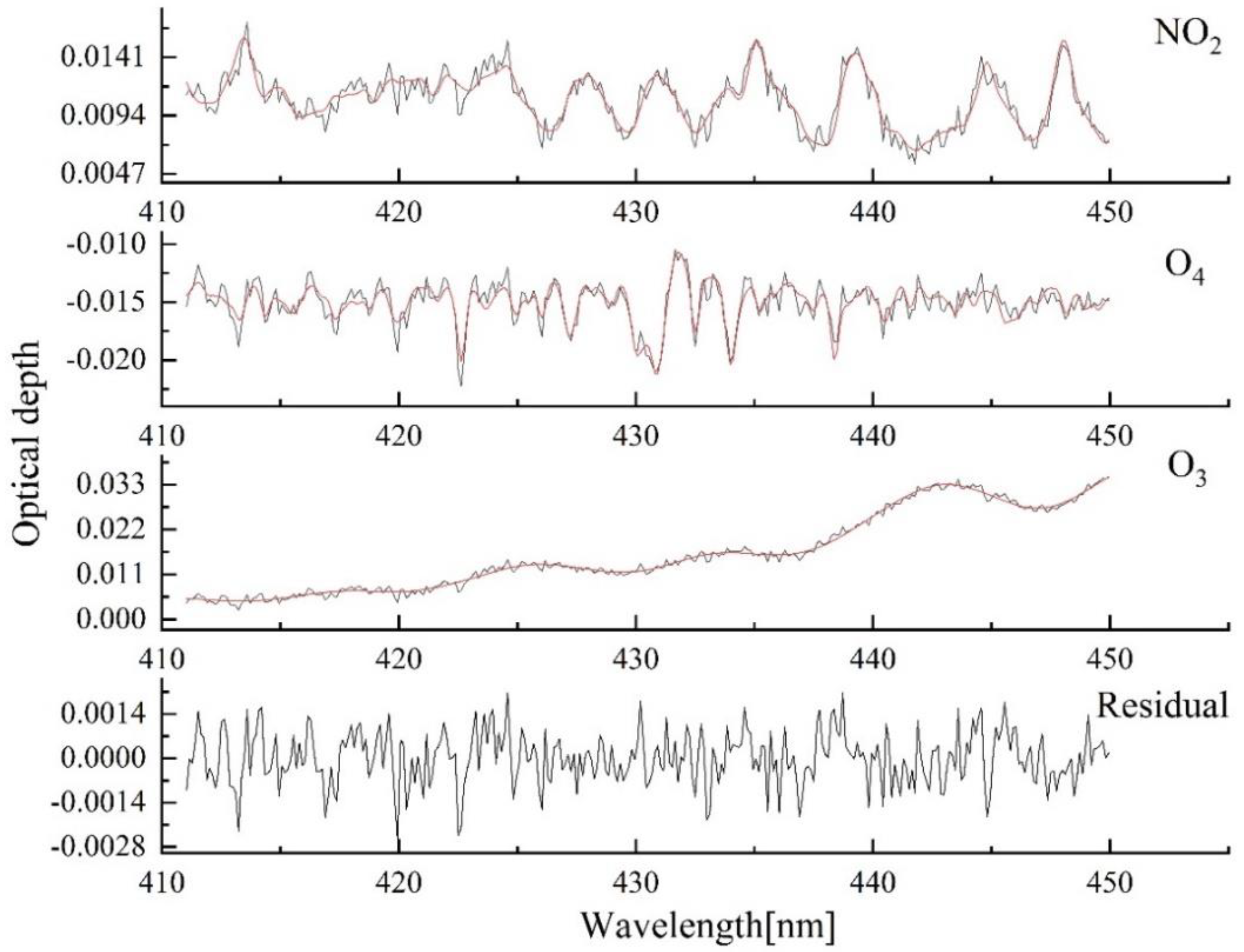
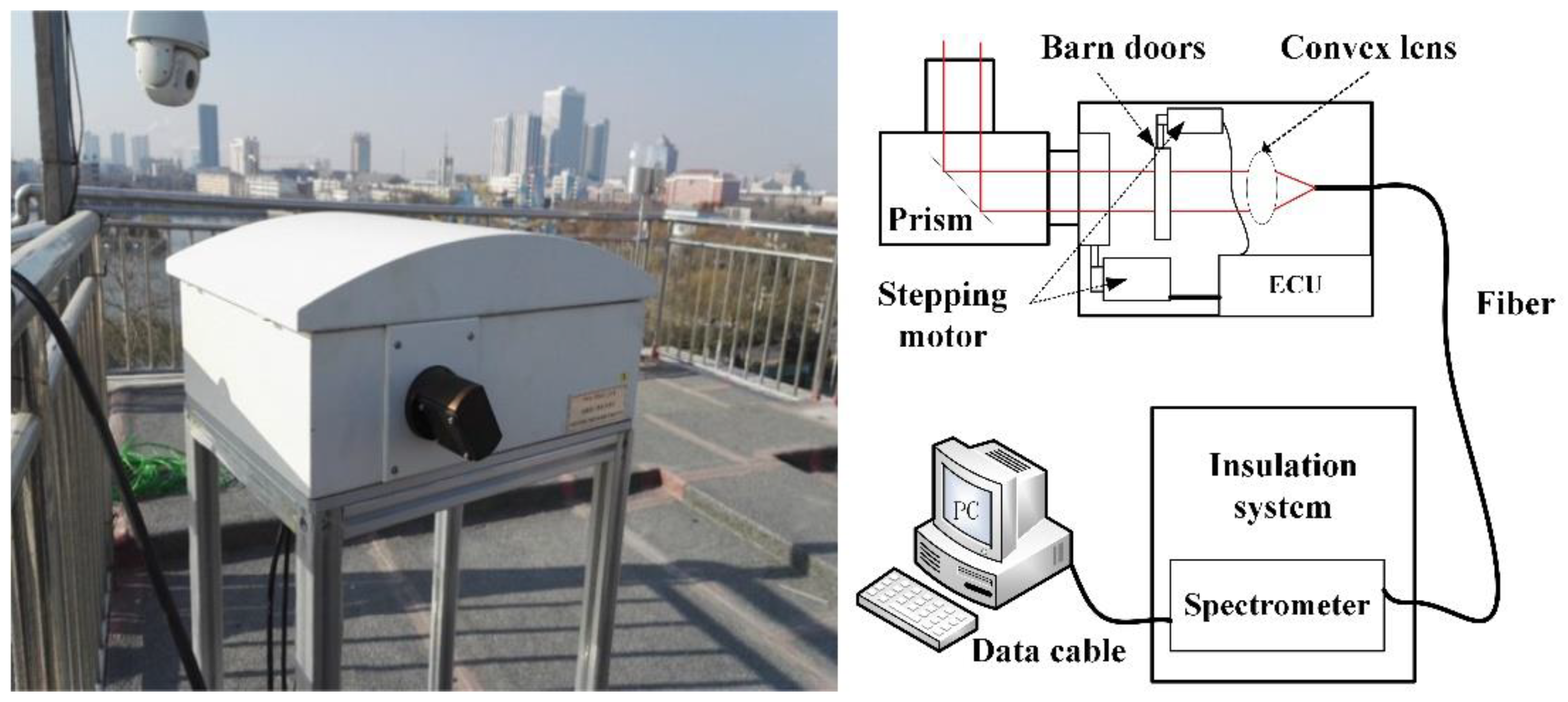

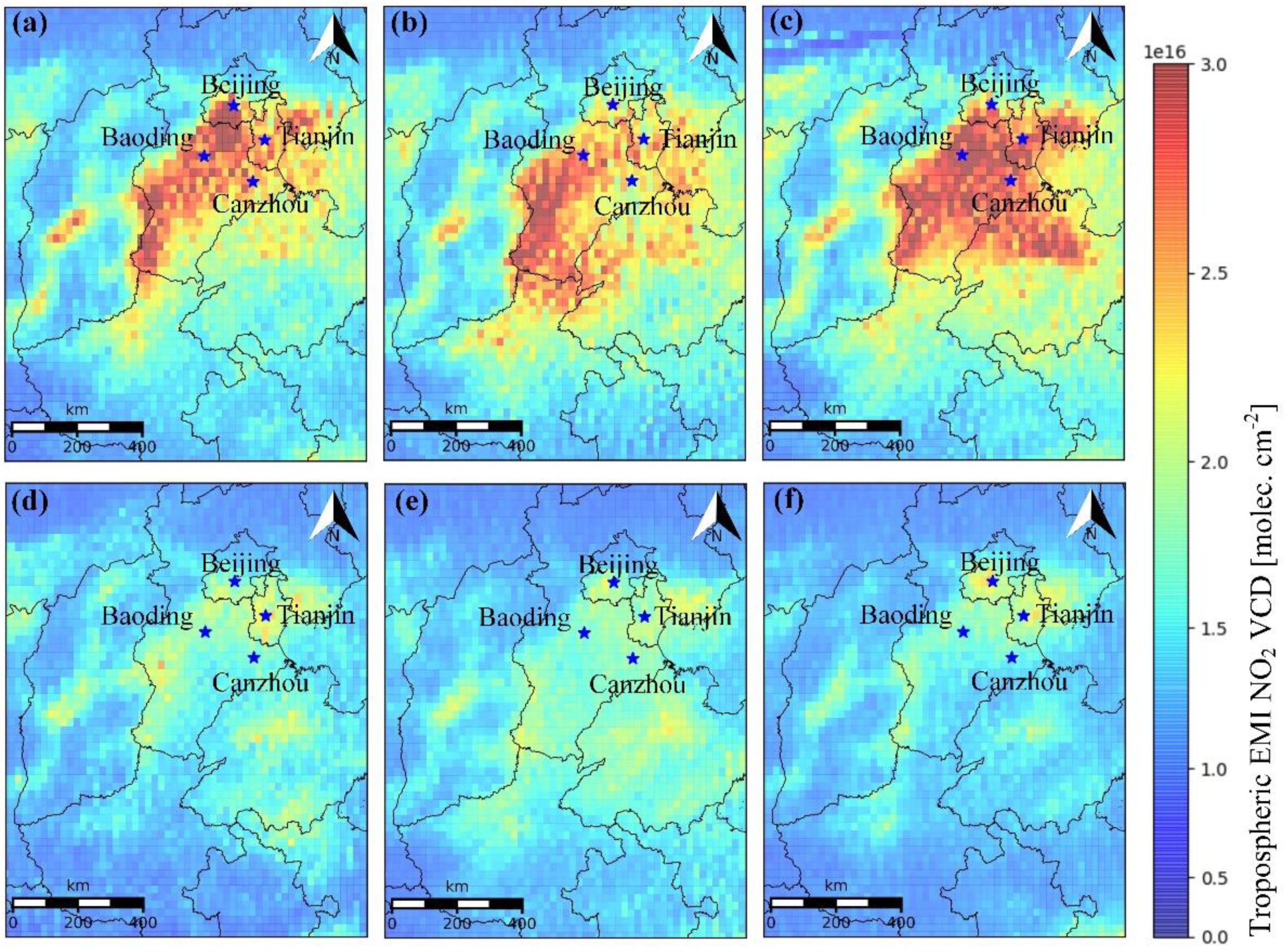
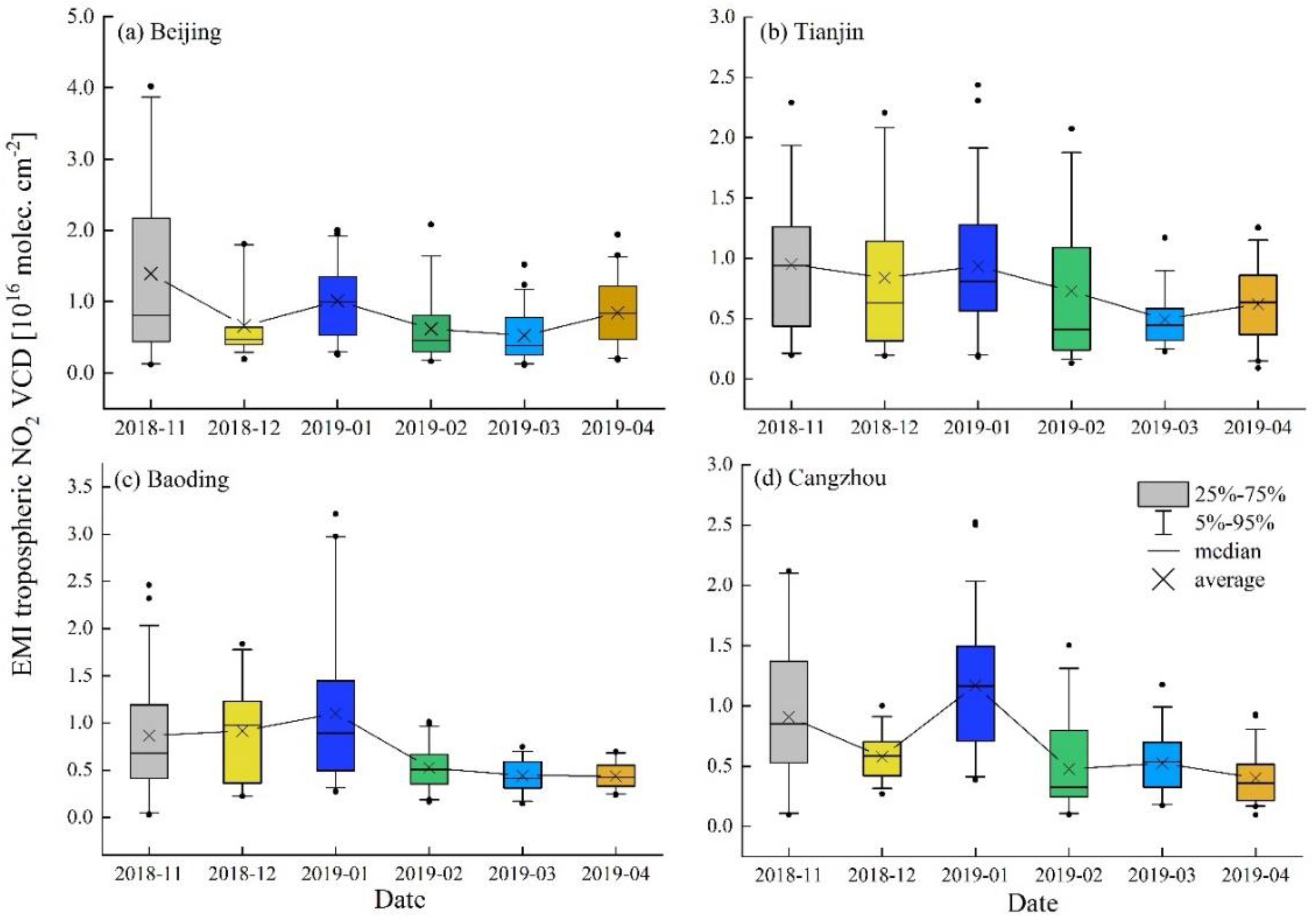
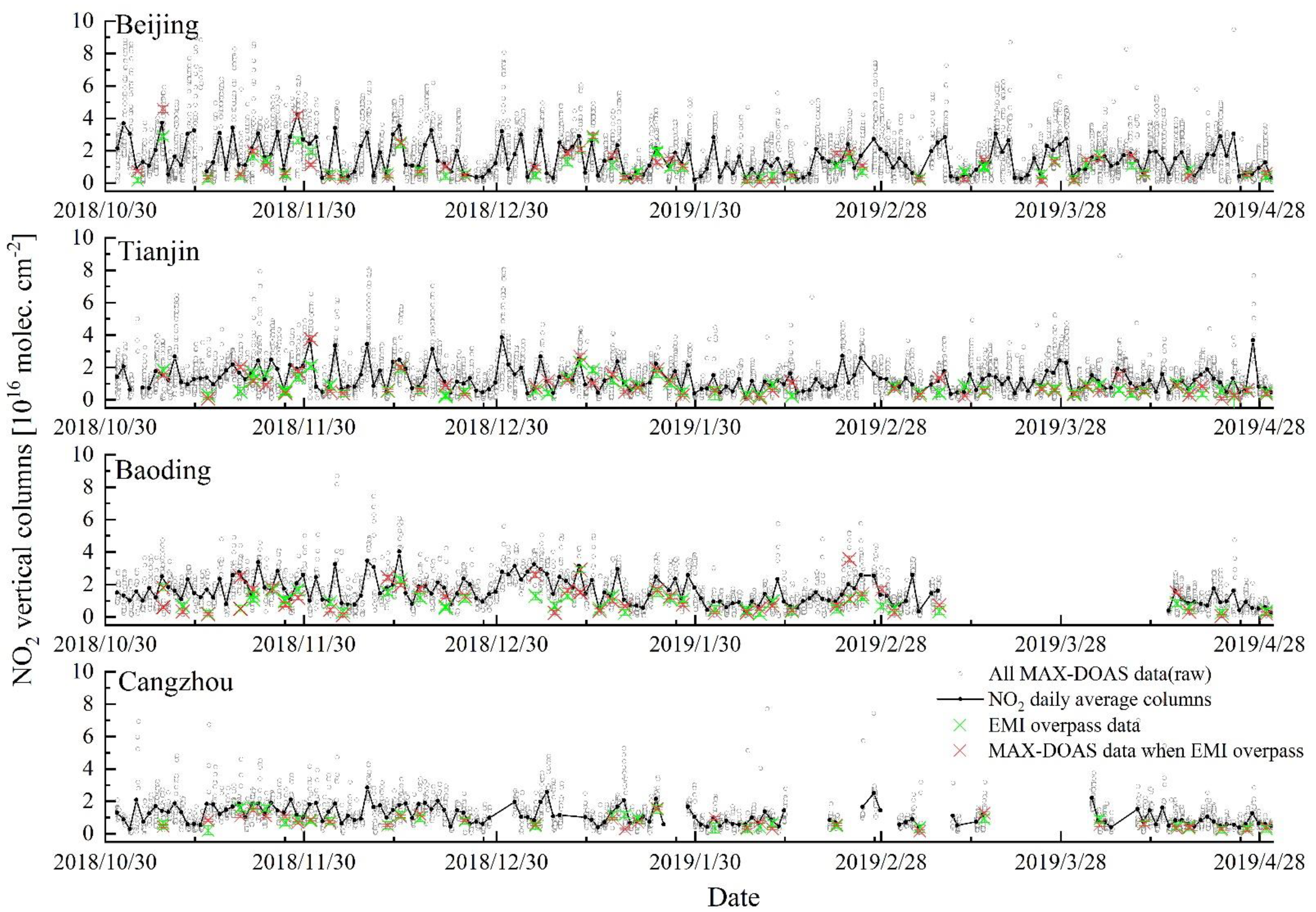

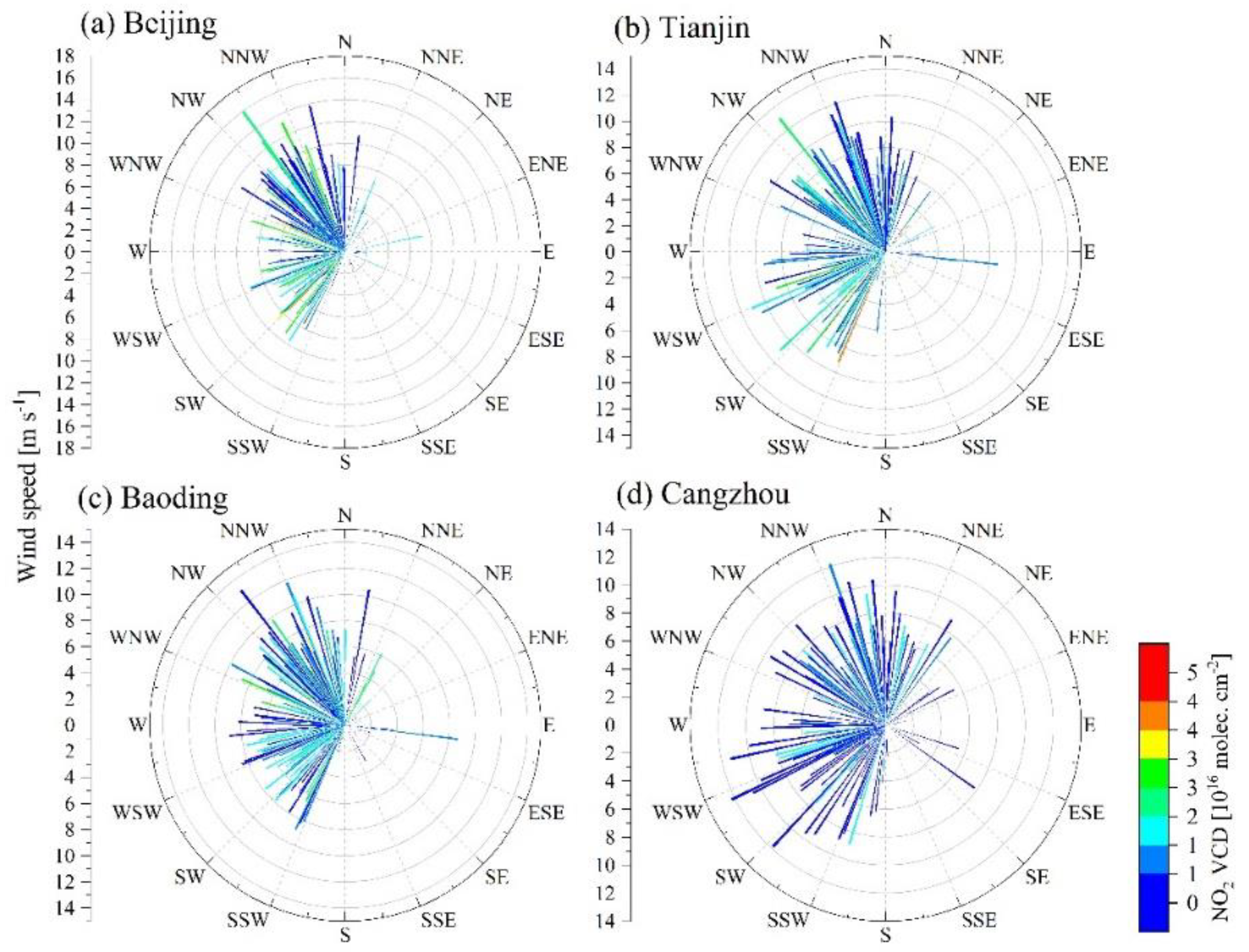

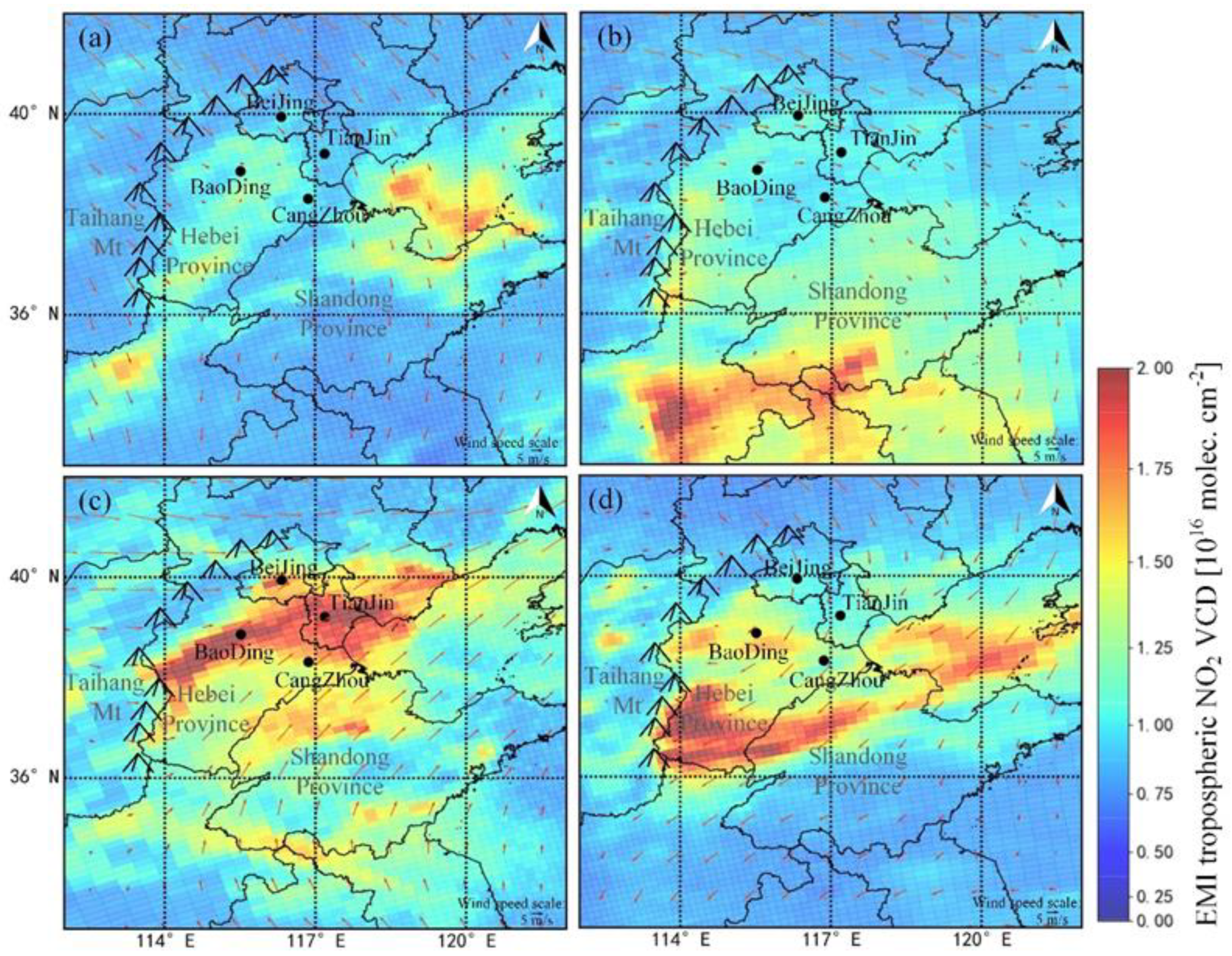
| Temperature | Data Source | Platform | ||
|---|---|---|---|---|
| EMI | MAX DOAS | |||
| Wavelength | - | - | 411–450 nm | 340–370 nm |
| NO2 | 220 K | Vandaele (1998) [39] * | √ | × |
| NO2 | 298 K | Vandaele (1998) [39] * | √ | √ |
| O3 | 223 K | Serdyuchenko (2014) [40] * | √ | √ |
| O3 | 243 K | Serdyuchenko (2014) [40] * | √ | √ |
| HCHO | 298 K | MellerMoortgat (2000) [41] * | × | √ |
| O4 | 293 K | Thalman and Volkamer (2013) [42] * | √ | √ |
| H2O | - | HITEMP (2010) ** | √ | × |
| ring | - | Calculated with QDOAS | √ | √ |
| Polynomial | 5th-order | 5th-order | ||
| Sites | Coordinates | Spectral Resolution | Observation Date | Azimuth |
|---|---|---|---|---|
| Beijing | 116.32° E, 39.95° N | 0.6 nm | 01.11.2018–30.04.2019 | 0° |
| Tianjin | 117.29° E, 39.69° N | 0.6 nm | 01.11.2018–30.04.2019 | 355° |
| Baoding | 115.514° E, 38.865° N | 0.3 nm | 01.11.2018–09.03.2019 14.04.2019–30.04.2019 | 18° |
| Cangzhou | 116.86° E, 38.31° N | 0.5 nm | 01.11.2018–16.03.2019 02.04.2019–30.04.2019 | 19° |
| Beijing | Tianjin | Baoding | Cangzhou | ||||||
|---|---|---|---|---|---|---|---|---|---|
| MAX-DOAS | EMI | MAX-DOAS | EMI | MAX-DOAS | EMI | MAX-DOAS | EMI | ||
| Fitting error, or | 1.1 | 0.92 | 0.92 | 1.01 | 1.2 | 0.91 | 0.86 | 0.9 | |
| stratosphere–troposphere separation error, | - | 0.76 | - | 0.76 | - | 0.76 | - | 0.76 | |
| AMF error, , | surface albedo | 0.23 | 0.39 | 0.16 | 0.32 | 0.27 | 0.41 | 0.2 | 0.34 |
| NO2 profile | 0.17 | 0.2 | 0.12 | 0.17 | 0.19 | 0.2 | 0.14 | 0.15 | |
| aerosol | 0.002 | 0.02 | 0.015 | 0.002 | 0.02 | 0.002 | 0.014 | 0.002 | |
| Total error | 1.1 | 1.3 | 0.9 | 1.3 | 1.2 | 1.3 | 0.9 | 1.2 | |
| Sites | Wind Speed | Wind Direction | Levene Test 1 | |
|---|---|---|---|---|
| Beijing | F | 0.005 | 2.348 | 1.669 |
| p | 0.944 | 0.007 | 0.072 | |
| Tianjin | F | 2.708 | 2.044 | 1.587 |
| p | 0.102 | 0.02 | 0.093 | |
| Baoding | F | 6.309 | 1.215 | 1.373 |
| p | 0.013 | 0.272 | 0.175 | |
| Cangzhou | F | 9.172 | 0.003 | 2.274 |
| p | 1.379 | 0.169 | 0.001 |
Publisher’s Note: MDPI stays neutral with regard to jurisdictional claims in published maps and institutional affiliations. |
© 2021 by the authors. Licensee MDPI, Basel, Switzerland. This article is an open access article distributed under the terms and conditions of the Creative Commons Attribution (CC BY) license (http://creativecommons.org/licenses/by/4.0/).
Share and Cite
Yang, D.; Luo, Y.; Zeng, Y.; Si, F.; Xi, L.; Zhou, H.; Liu, W. Tropospheric NO2 Pollution Monitoring with the GF-5 Satellite Environmental Trace Gases Monitoring Instrument over the North China Plain during Winter 2018–2019. Atmosphere 2021, 12, 398. https://doi.org/10.3390/atmos12030398
Yang D, Luo Y, Zeng Y, Si F, Xi L, Zhou H, Liu W. Tropospheric NO2 Pollution Monitoring with the GF-5 Satellite Environmental Trace Gases Monitoring Instrument over the North China Plain during Winter 2018–2019. Atmosphere. 2021; 12(3):398. https://doi.org/10.3390/atmos12030398
Chicago/Turabian StyleYang, Dongshang, Yuhan Luo, Yi Zeng, Fuqi Si, Liang Xi, Haijin Zhou, and Wenqing Liu. 2021. "Tropospheric NO2 Pollution Monitoring with the GF-5 Satellite Environmental Trace Gases Monitoring Instrument over the North China Plain during Winter 2018–2019" Atmosphere 12, no. 3: 398. https://doi.org/10.3390/atmos12030398
APA StyleYang, D., Luo, Y., Zeng, Y., Si, F., Xi, L., Zhou, H., & Liu, W. (2021). Tropospheric NO2 Pollution Monitoring with the GF-5 Satellite Environmental Trace Gases Monitoring Instrument over the North China Plain during Winter 2018–2019. Atmosphere, 12(3), 398. https://doi.org/10.3390/atmos12030398







